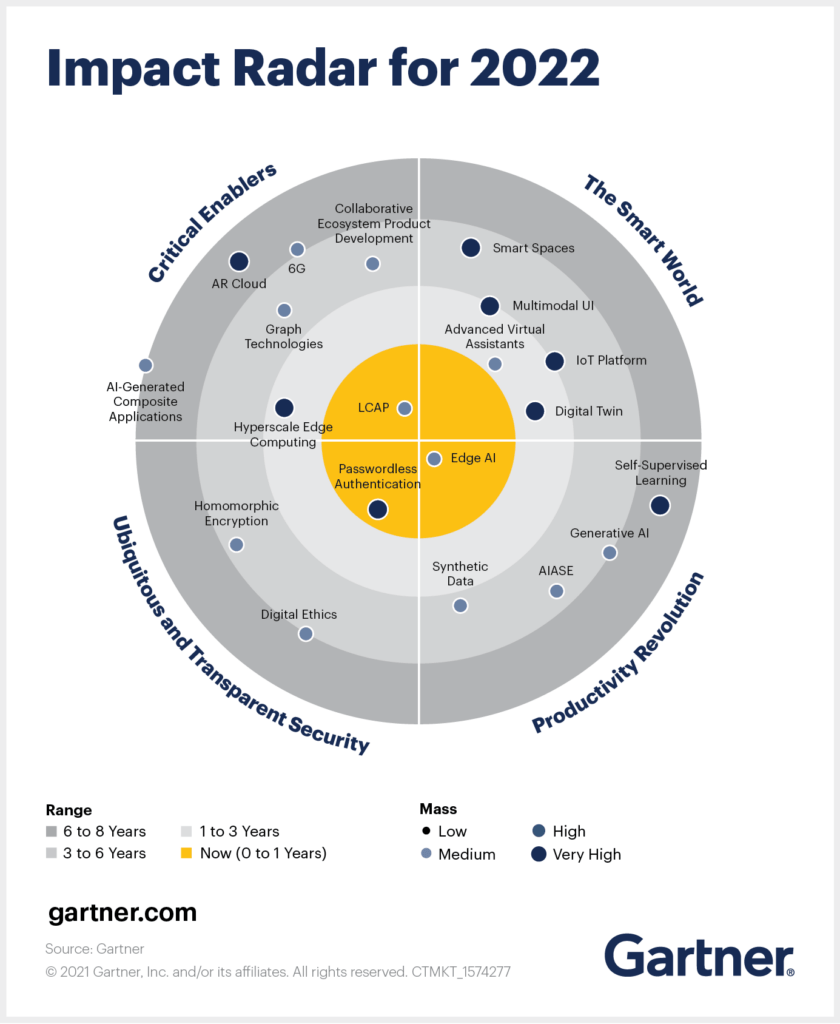Source: Gartner, Inc
Smart spaces, homomorphic encryption, generative AI, graph technologies and the metaverse will disrupt and transform entire markets.
Wouldn’t it be helpful if a building could tell you when a filter in the HVAC system was causing the system to function inefficiently and needed changing? What if it adjusted the heat or air based on usage? Does your current system actively track the air quality within the building or ensure that there aren’t too many people to comply with COVID-19 recommendations?
Smart spaces are capable of all these tasks, and product leaders should consider how they’ll factor into future business opportunities alongside potential investments.
Included in this year’s Emerging Technologies and Trends Impact Radar are 23 emerging trends and technologies with the most potential to disrupt and transform markets.
These trends center around four key themes:
- The smart world: Change how people interact with the world around them.
- Productivity revolution: Build on core AI technologies and extend computing ability.
- Ubiquitous and transparent security: Underscore the importance of protecting an increasingly digital world.
- Critical enablers: Act as an additive force to bring the emerging technologies and trends together, and heighten the benefits by reshaping business practices, processes, methods, models and/or functions in markets where they are applied.
A quick reminder on how to look at the radar: The rings represent the range, which estimates the number of years it will take until the technology or trend crosses from early adopter to early majority adopter. The size and color of the emerging technology — or trend radar blip — represent the technology’s mass; in other words, how substantial the impact of the technology or trend will be on existing products and markets.

Most of this year’s emerging technologies and trends are three to eight years out from reaching early majority. This signals that significant innovation will happen in the years ahead. Let’s look at the five we think will prove most interesting.
Smart Spaces
Time to market: 3-6 years
Mass: High
Theme: The Smart World
A smart space is a physical or digital environment in which humans and technology-enabled systems interact in increasingly open, connected, coordinated and intelligent ecosystems. Smart spaces can be referred to by a variety of names, including “smart cities,” “digital workspaces,” “smart venues” and “ambient intelligence.”
Common uses include preventive maintenance for building infrastructure, and automated tolls and billing. Smart spaces are changing how people interact with one another and influence decision support systems within various spaces (e.g., buildings, factories and venues).
COVID-19 accelerated market adoption of smart spaces, as worker safety and social distancing capabilities became de facto standards. As organizations embrace the ability of smart spaces to incorporate legacy systems alongside new technologies like IoT, we’ll see increasing opportunities to drive more connected, coordinated and intelligent solutions across target environments.
Smart spaces have a very high mass because they offer broad, cross-industry appeal wherever people and mobile traffic require observation and management.
Generative AI
Time to market: 6-8 years
Mass: High
Theme: Productivity Revolution
Generative AI refers to AI techniques that learn a representation of artifacts from the data and use it to generate brand-new, completely original artifacts that preserve a likeness to original data.
The field of generative AI will progress rapidly in both scientific discovery and technology commercialization. While this is currently as futuristic as it gets, we already see successes in a wide range of applications, from creating new materials to preserving data privacy. However, safety concerns and negative use of generative AI, such as deepfakes, might slow adoption in some industries.
Generative AI mass is high, because exploration of generative AI methods is growing and proving itself in a wide range of industries, including life sciences, healthcare, manufacturing, material science, media, entertainment, automotive, aerospace, defense and energy.
Homomorphic Encryption
Time to Market: 3-6 years
Mass: High
Theme: Ubiquitous and Transparent Security
Homomorphic encryption is a cryptographic method that returns an encrypted result to the data owner. Essentially, this enables third parties to process encrypted data while having no knowledge about the data or the results.
Several factors prevent near-term adoption of the technology, including performance issues, lack of standardization and complexity. Pioneers of homomorphic encryption understand that the future of this technology is tied to the increasing role of open innovation investments, which runs counter to the secrecy and silo mentality of traditional corporate research labs.
We believe homomorphic encryption will be a core technology for many future SaaS offerings to ensure the protection and privacy of data between third-party data processing and analytics providers. The dominant use case will be eliminating the current need to exchange and store data between business partners, third-party analysis firms or other extended data analytics solutions.
Graph Technologies
Time to market: 3-6 years
Mass: High
Theme: Critical Enablers
Graph technologies refer to graph data management and analytics techniques. This group of technologies enables the exploration of relationships between entities like organizations, people or transactions. Analyzing relationship data can require a large volume of heterogeneous data, storage and analysis — none of which is well-suited to relational databases. Graph analytics consists of models that determine the “connectedness” across data points.
Essentially, graph technologies determine “connectedness”/relationship between varied datasets. Take the example of social media analysis: These technologies can enhance the identification of influencers and communities in social media networks by evaluating when different paths spread behavior through unexpected community members.
The wide range of potential applications for graph technologies means it will take three to six years to reach early majority adoption. A significant proportion of these technologies will be sold as integrated components of existing data platforms, either developed in-house or integrated via resale agreements from specialist vendors.
Graph databases are ideal for storing, manipulating and analyzing the widely varied perspectives in the graph model due to their graph-specific processing languages and capabilities, scalability and computational power.
The Metaverse: Outside Eight Years but Meriting Awareness
One other noteworthy trend is the metaverse. Though this trend is outside of the eight-year time frame that usually dictates what we include in this research, it extends computing ability by an order of magnitude beyond what is available today and fundamentally changes how individuals and organizations interact with each other and the world.
The metaverse is a persistent and immersive digital environment of independent, yet interconnected networks that will use yet-to-be-determined protocols for communications. It enables persistent, decentralized, collaborative, interoperable digital content that intersects with the physical world’s real-time, spatially oriented and indexed content.
The metaverse is the next evolutionary stage of the internet, but it is still in the early stage of its development. We expect the transition toward the metaverse to be as significant as the one from analog to digital.
While the benefits and opportunities from the metaverse are not immediately viable, emergent metaverse solutions indicate potential use cases. Although metaverse experiences will not completely replace current digital interactions (via apps, websites and so on), they are likely to displace many of them while opening up new types of interactions and business models to optimize on these new use cases.
Gartner, Inc is a technological research and consulting firm based in Stamford, Connecticut that conducts research on technology and shares this research both through private consulting as well as executive programs and conferences. Its clients include large corporations, government agencies, technology companies, and investment firms.
ကြော်ညာ တွေဆိုတာ အောက် ပြတဲ့ ဟာတွေဖြစ်တယ်။ ကလစ်ပြီး သူတို့ website မှာ အနဲဆုံး ၁ minute လောက်နေပေးပါ
ကြော်ညာ 2
++++++++++++++

